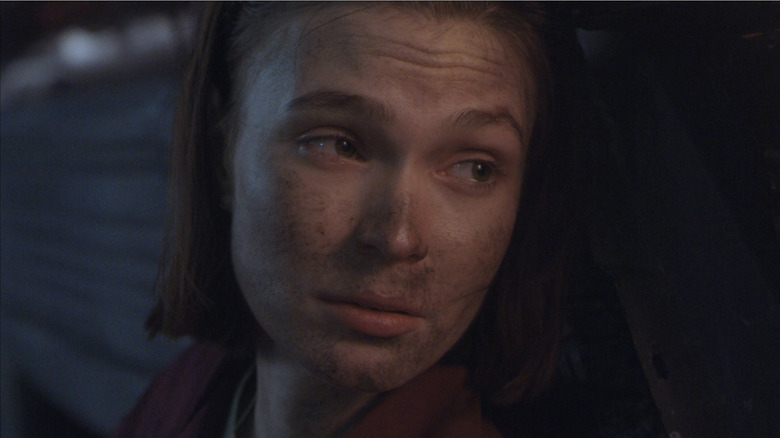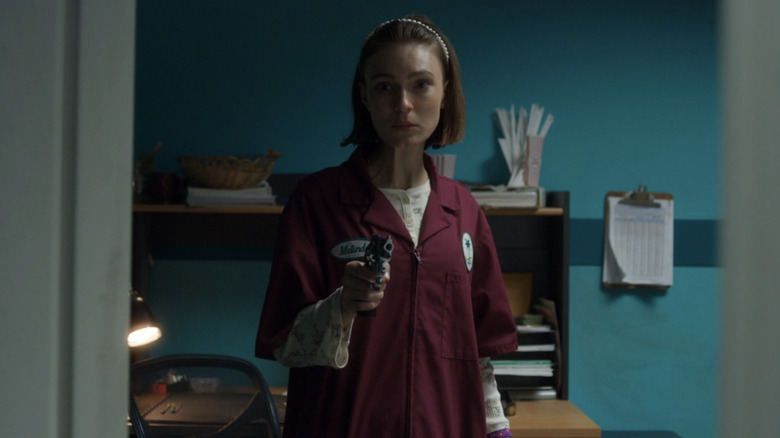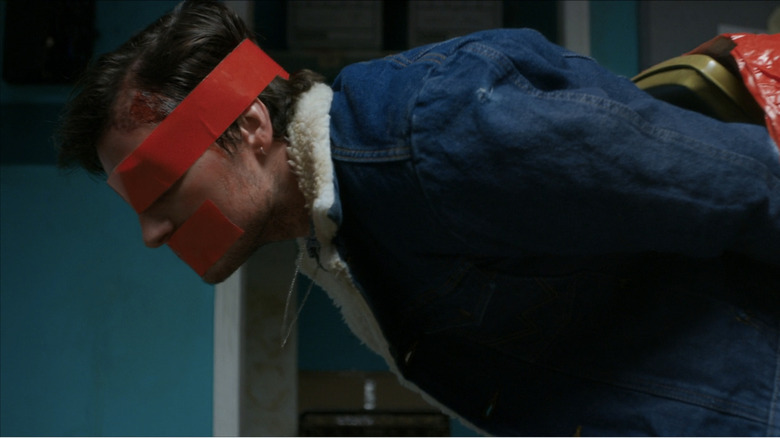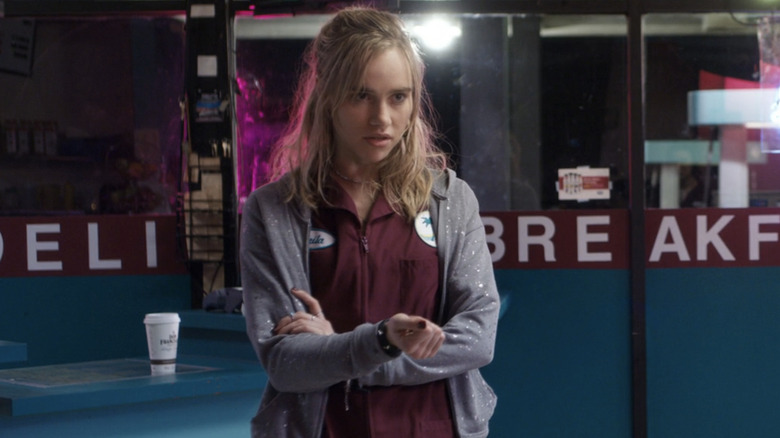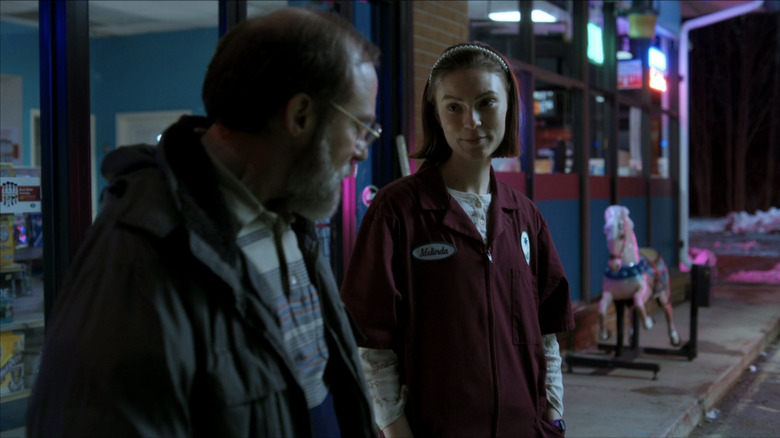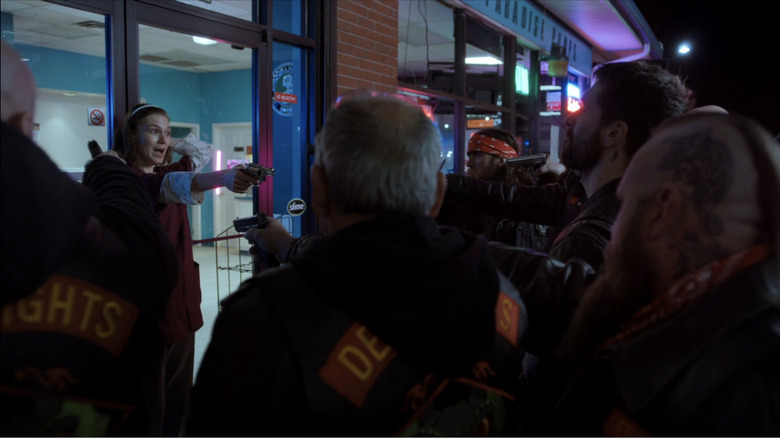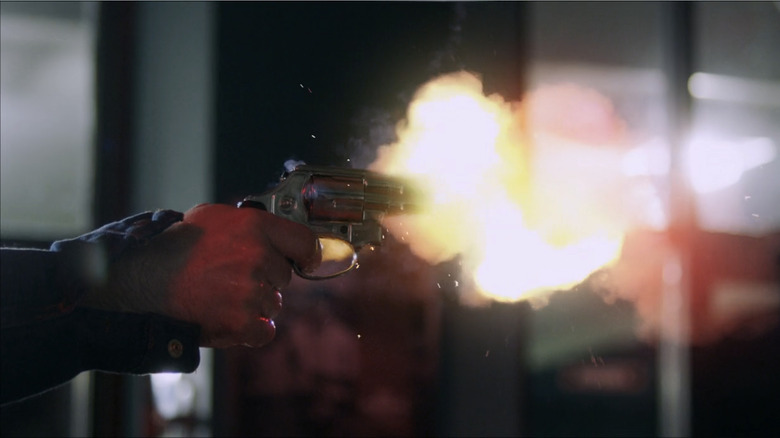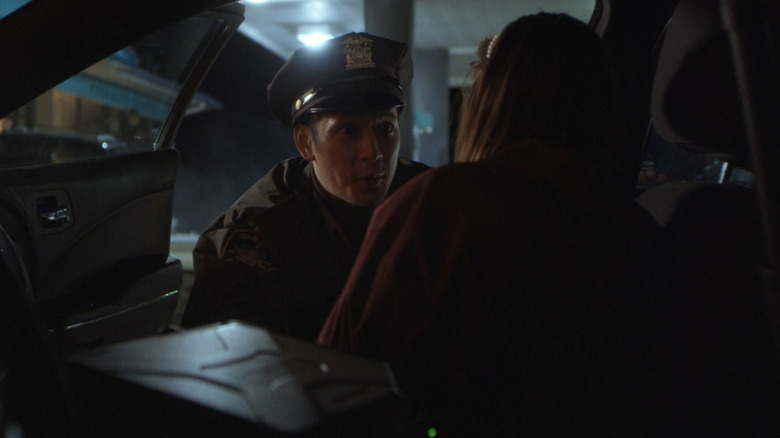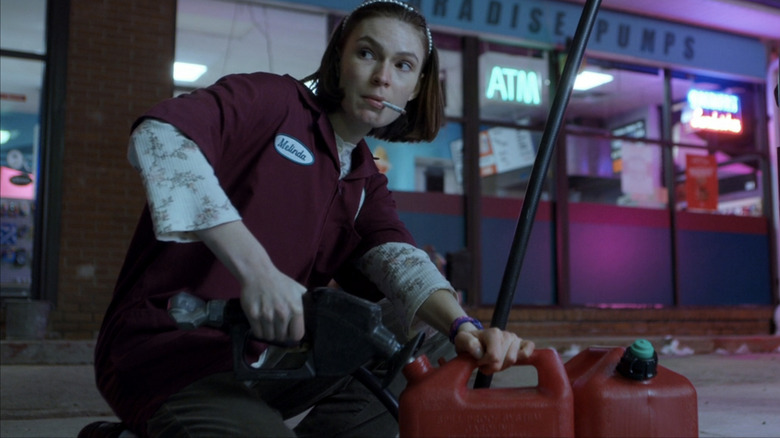The Ending Of Burn Explained
Mike Gan's 2019 feature film debut "Burn" ends, true to its title, with two people on fire. One is a perpetrator and the other a victim, one will live while the other is likely dead. But which one is which? This thorny, black comic thriller unfolds around a single physical location — a tropical-themed gas station in snowy upstate New York — in what feels like real time, but where the film really takes place is the psychological battleground of its two lead characters, who both began the night expecting an easy job but instead are plunged into the darkest depths.
Writer-director Gan and his on-screen collaborators, Australian actor Tilda Cobham-Hervey and "Hunger Games" star Josh Hutcherson, keep the film off-kilter for its entire 90-minute runtime. Nothing quite works the way the audience might expect. From the way the relationship between Cobham-Hervey and Hutcherson's characters feints at a latter-day "Bonnie and Clyde" before mutating into something more disturbing, to the way the script builds up the threat of a dangerous biker game only to fizzle it after one scene, the film constantly zigs where viewers think it will zag. In its final moment, one character asks another what happened inside that blazing gas station; the actual events are only half the story. Below, a look at the end of "Burn."
What you need to remember about the plot
At the start of the film, Melinda (Cobham-Hervey) settles in for another late night shift at the Paradise Pumps filling station, somewhere in the New York backwoods, along with her co-worker Sheila (Suki Waterhouse, "Daisy Jones & The Six"). Melinda is desperately lonely, but her attempts at connection are met with hostility from the strangers at the station and bullying from Sheila. Their coldness may seem cruel, but it's at least somewhat justified; there is an unsettling air to Melinda, the sense that her surface friendliness is masking a deeper hostility. When she's caught taking a candid picture of Sheila talking to friendly Officer Liu (Harry Shum, Jr.), the two discover that she has an entire album on her phone of secret photos of Liu.
There's a sense that Melinda is on the verge of a nervous breakdown even before Billy (Hutcherson), a denim-clad charmer, shows up with a pistol and demands the gas station's cash. Sheila is unimpressed by this baby-faced stick-up artist, as she should be; he didn't lock the front doors, so customers keep coming in even in the middle of his robbery attempt. Melinda, on the other hand, almost immediately becomes his unwanted accomplice, giving him the cash out of the office safe and offering to join him on the lam. But when Billy and Sheila's sniping turns violent, Melinda tries to protect her coworker by knocking Billy unconscious with a fire extinguisher. In the struggle, Billy's pistol fires, striking Sheila in the head and killing her instantly.
What happened at the end
Melinda ties up an incapacitated Billy in the backroom and covers up Sheila's dead body. When he comes to, he begs to be let go, promising to take Melinda with him wherever he goes. Melinda relishes the power she has over Billy in this moment; she pulls his pants down and attempts to rape him. Her attempt is interrupted by Officer Liu, who is tracking a suspect (presumably Billy) in a robbery earlier in the night. Powerless to stop him, Melinda nervously lets Liu search the gas station, but is shocked when he doesn't see anything suspicious, even in the back room. Billy has escaped his bindings and disappeared.
In a panic, Melinda douses Sheila's body and the rest of the store in gasoline — including Billy's pistol. When Sheila's jealous boyfriend Perry (Shiloh Fernandez) shows up to find her, Melinda tries to shoo him away, but Billy reappears, begging Perry to give him a ride and telling him that Melinda murdered Sheila. When a confused Perry fails to act fast enough, Billy kills him with the station's air compressor and steals his car. Distraught, Melinda calls Officer Liu and asks him to come back.
Before long, however, Billy rams his stolen car into the doors of the store. Back to tie up loose ends and kill Melinda, he attempts to shoot her with his pistol, but the spark of the firing pin ignites the lingering gasoline. Billy and the store are engulfed in flames. Melinda escapes into the arms of Officer Liu, albeit with severe burns on her legs.
If you or anyone you know has been a victim of sexual assault, help is available. Visit the Rape, Abuse & Incest National Network website or contact RAINN's National Helpline at 1-800-656-HOPE (4673).
Burn's dark comedy influences
"Burn" goes to some harrowing places, especially in that mid-film backroom scene, but the film also has its share of dry humor. The opening 15 minutes are largely a droll workplace comedy about a pair of weirdos and their go-nowhere job, not unlike Kevin Smith's 1994 breakthrough "Clerks." Billy's early fumbling attempts at robbing the gas station are likewise played for laughs, from his inability to keep customers away, to the well-observed fact that 21st century gas stations aren't likely to have mounds of cash on hand, to even the casting of former child actor Hutcherson, still best known as one of Katniss Everdeen's two non-threatening boyfriends.
Things turn much more grim as the movie continues, of course, but it never quite loses that comedic edge. It's a very tricky tone to strike, and in interviews when the film came out, Gan cited two major works as his guiding stars: Bong Joon-ho's 2009 thriller "Mother" and the Coen brothers' Oscar-winning 1996 crime drama "Fargo." The "Fargo" influence on "Burn" is arguably the more clearly felt, with its snowy atmosphere, colorful locals, and small-time crime that turns progressively deadly. "Mother," however, is a more intriguing comparison. On paper, the two films have little to do with one another, but Bong's dark tale of a mother going to horrifying lengths to defend her son from a murder accusation reflects on how violence has a way of justifying itself, as one desperate act leads to another.
The film was shot inside an actual gas station
To film their thriller set entirely at a gas station in upstate New York, Gan and his crew found exactly that: A gas station in upstate New York, filming at night over 12 days in the dead of winter. In an interview with Rue Morgue when the film came out, Gan said that his focus was on the actors and the way that the script charts their characters' phases over the course of one awful night, so much so that the literal setting in which the drama played out was incidental.
"As long as you could connect with [what the characters were going through]," he explained. "It almost didn't matter where the location was." While other filmmakers might have used that perspective as an excuse to make their film in a more hospitable climate, the "Burn" unit braved sub-freezing temperatures and a blizzard that delayed filming for several days, not to mention sound issues created by traffic from the nearby highway.
While the decision to film on location was mostly financial for Gan and the film's producers, for the actors it was an immersive, almost theatrical experience — a feeling that German director Werner Herzog once described as the "voodoo of location." Cobham-Hervey, also speaking to Rue Morgue, said she came to think of the gas station as its own character and relished the opportunity to play in its space, especially since this was her first time working in the United States. "When you're somewhere so far from your own home," she explained, "that pushes you to live within that world."
The red herring bikers
Billy doesn't stick up gas stations for the thrill of it, that much is clear from the very beginning. So why is he doing it? The explanation he gives is that he owes money to a local biker gang — real tough characters, apparently. He fears that he won't have enough cash to pay his debts, and that they will find him. Until he is imprisoned by Melinda, the biker gang appears to be his primary motivation, and when he tells her the gang knows where he is, it sets the audience up to expect a climactic confrontation between some or all of these characters, elevating this tense two-hander into a big bloody shootout.
But when the biker gang does show up, as big and bad as Billy said, they only stick around for one scene; Melinda successfully keeps them from coming into the gas station, where they would no doubt find Billy's bound and unconscious body in the back room, and they ride off again. It's a fascinating dramatic swerve, and purposely anti-climactic. But while that may be frustrating for audience members hankering for a big bloody shootout, it's really the only choice. The film has never been about Billy versus the biker gang, but rather Melinda versus the demons let loose by Billy's transgression. "Have you lost your f**king mind?!" one of the bikers barks when Melinda pulls Billy's pistol on him. She answers that rhetorical question honestly: "It's very possible."
Can gasoline really ignite from a pistol?
The film's fiery climax comes courtesy of a payoff set up in one of its first scenes. As Melinda arrives at work, she gently asks a customer filling up his car to put out his cigarette while standing so close to an open gas tank. The customer responds harshly to her very reasonable request, but the scene foreshadows the inferno to come — and gives the audience a quick reminder that gasoline is extremely flammable. Melinda later douses the store with gas after Billy escapes, in order to cover up Sheila's death (and perhaps live out a long-buried fantasy), but before she can set the blaze herself, Billy does it for her by accident, courtesy of the firing pin in his pistol.
But is the tiny spark of a low-caliber revolver enough to ignite gasoline, or is this a bit of movie magic, like in the similarly explosive (and physics-defying) ending of "Jaws?" Most likely it's the latter. For one thing, it is not the liquid form of gasoline that is dangerously flammable, but rather the fumes it gives off. For another, those fumes dissipate quickly, so the fact that the pistol was soaked in gas earlier would likely be a non-issue. To flare up the way it does, the air in the room would need to be so choked with gasoline fumes that Billy and Melinda would not be able to breathe.
A quick YouTube search will turn up plenty of amateur mythbusters trying and failing to ignite gasoline with guns, lighters, and such, just like in the movies. However, gasoline remains extremely dangerous, and this article is in no way an endorsement of shooting up gas stations for the fun of it.
Will Melinda tell the truth about what happened?
"Melinda, what happened tonight?" Officer Liu asks after pulling her to safety and calling for an ambulance. It's the final line of the film, and the credits roll before viewers can hear her response. What could her response even be, though? That she was Billy's willing accomplice in the robbery? That she was indirectly involved in Sheila's death? That she tied Billy up and attempted to sexually assault him? That the store is burning because she poured gasoline over everything to cover her tracks? Before her final confrontation with Billy, Melinda seemed willing and ready to confess everything to Officer Liu, but now, sitting in his prowler and basking in the glow of his undivided attention, the truth might not come out so easily.
Self-preservation is a good enough reason to keep her mouth shut, but there is another element, too. The events of the night have clearly awakened something within Melinda, a disturbing and sadistic streak that led her to not only meet the violence of the moment — knocking out Billy, pulling a gun on the bikers — but to take it to uncomfortable new lengths.
Cobham-Hervey saw the character as a "naive, innocent dreamer" and someone who is always looking for "positive connections," even if her methods are, to put it lightly, questionable. Keeping the truth from Officer Liu might keep Melinda out of prison, but it creates a distance between them, as Liu will only ever see her as a suffering victim. It's possible that Melinda will tell the truth in an effort to not just connect with her longtime crush, but to revel in the darkness that was within her all along.
What's next for the cast and crew of Burn?
Gan had directed television episodes and music videos, but "Burn" is his first, and so far only, feature. In interviews around the release of the film, he talked up a script he was writing and planning to direct that was rooted in Chinese folklore and set among a group of "assimilated Chinese Americans, living in Los Angeles," but as of 2023 no further news on that project is available. In 2020 he scripted, along with writer Catherine Wignall, an episode of Hulu's horror anthology series "Into the Dark." A year later it was announced that Gan was attached to the long-gestating thriller "Dead of Winter," a Black List-awarded screenplay that had bounced between a number of directors over the years, but there has been no further development on that project either.
In the years since "Burn," Hutcherson has starred in the Hulu sci-fi comedy series "Future Man" and provided the English voice of the classic Japanese superhero Ultraman in the recent Netflix revival anime. Cobham-Hervey has yet to have her big American break, but her star in Australia has continued to rise. The same year as "Burn," she starred as singer/activist Helen Reddy alongside Evan Peters in the biopic "I am Woman," and in 2021 she headlined the sci-fi-tinged Joseph Conrad adaptation "Lone Wolf," alongside "The Matrix" villain Hugo Weaving. Cobham-Hervey has some high-profile roles coming down the pike as well, including "Young Woman and the Sea" (a Daisy Ridley-starring biopic about the first woman to swim the English Channel) and an Amazon miniseries based on Holly Ringland's "The Lost Flowers of Alice Hart."
Will we ever see a Burn 2?
Among the slate of upcoming projects for Gan and Cobham-Hervey, one that does not appear on the horizon is a "Burn" sequel. To be fair, the film is pretty self-contained, with most of its characters dead by its conclusion and the primary setting likely burned to the ground. But there is something undeniably compelling about Melinda, and her psychosis — looking for love in all the wrong places, as it were — is the kind of thing that could presumably fuel further violent adventures.
If a proper sequel isn't in the cards, perhaps filmgoers could see Gan and Cobham-Hervey re-team for a new project down the line. Both filmmaker and star were very complimentary of one another during the press tour for the movie, and their collaboration resulted in an ingenious thriller with a tremendous, disturbing performance at its heart. It would be very exciting to see what these two artists might come up with next.
